Life Cycle Sustainability Assessment of the Spanish Electricity: Past, Present and Future Projections
Abstract
1. Introduction
2. Methodology
2.1. Life Cycle Assessment Methodology
2.2. Inventory Data of Installed Capacity, Electricity Generation and Technology Mix
2.2.1. Historic Electricity Data
2.2.2. Future Projections
2.3. Sustainability Factors of Power Generation Technologies
2.3.1. Environmental Dimension
2.3.2. Economic Dimension
2.3.3. Socio-Economic Dimension
3. Results and Discussion
3.1. Environmental Sustainability Assessment
3.1.1. Electricity Costs in Historic and Present Data
3.1.2. Electricity Costs in Future Projections
3.2. Socio-Economic Sustainability Assessment
3.2.1. Employment Generation in Historic and Present Situation
3.2.2. Employment in Future Projections
4. Conclusions
Author Contributions
Funding
Conflicts of Interest
References
- World Bank. State of Electricity Access Report 2017; World Bank: Washington, DC, USA, 2017; ISBN 1202522262. [Google Scholar]
- United Nations. Sustainable Development Report 2019: Transformations to Achieve the Sustainable Development Goals; United Nations: New York, NY, USA, 2019. [Google Scholar]
- Nuclear Energy Agency. The Full Costs of Electricity Provision; OECD: Paris, France, 2018; ISBN 9789264303119. [Google Scholar]
- IRENA. Renewable Power Generation Costs in 2017; International Renewable Energy Agency: Abu Dhabi, UAE, 2018; ISBN 978-92-9260-040-2. Available online: http://irena.org/publications/2018/Jan/Renewable-power-generation-costs-in-2017 (accessed on 12 February 2020).
- Turconi, R.; Boldrin, A.; Astrup, T. Life cycle assessment (LCA) of electricity generation technologies: Overview, comparability and limitations. Renew. Sustain. Energy Rev. 2013, 28, 555–565. [Google Scholar] [CrossRef]
- Barros, M.V.; Salvador, R.; Piekarski, C.M.; de Francisco, A.C.; Freire, F.M.C.S. Life cycle assessment of electricity generation: A review of the characteristics of existing literature. Int. J. Life Cycle Assess. 2020, 25, 36–54. [Google Scholar] [CrossRef]
- WG Environmental Management & Economics. Eurelectric, Life Cycle Assessment of Electricity Generation. 2011. Available online: http://www.eurelectric.org/media/26740/report-lca-resap-final-2011-420-0001-01-e.pdf (accessed on 15 July 2019).
- European Commission. Directive 2009/28/EC of The European Parliament and of the Council of 23 April 2009 on the Promotion of the Use of Energy from Renewable Sources; European Commission: Brussels, Belgium, 2009. [Google Scholar]
- European Commission. EU Climate Action. Available online: https://ec.europa.eu/clima/policies/eu-climate-action_en (accessed on 15 February 2020).
- European Commission. A Clean Planet for all a European Strategic Long-Term Vision for a Prosperous, Modern, Competitive and Climate Neutral Economy; COM/2018/773 final 2018; European Commission: Brussels, Belgium, 2018. [Google Scholar]
- IPCC. Climate Change 2014: Synthesis Report; Contribution of Working Groups I, II and III to the Fifth Assessment Report of the Intergovernmental Panel on Climate Change; Pachauri, R.K., Meyer, L.A., Eds.; IPCC: Geneva, Switzerland, 2014. [Google Scholar]
- IRENA. Rethinking Energy 2017; IRENA: Abu Dhabi, UAE, 2017; Volume 55, ISBN 978-92-95111-06-6. [Google Scholar]
- Santoyo-Castelazo, E.; Stamford, L.; Azapagic, A. Environmental implications of decarbonising electricity supply in large economies: The case of Mexico. Energy Convers. Manag. 2014, 85, 272–291. [Google Scholar] [CrossRef]
- Azapagic, A.; Chalabi, Z.; Fletcher, T.; Grundy, C.; Jones, M.; Leonardi, G.; Osammor, O.; Sharifi, V.; Swithenbank, J.; Tiwary, A.; et al. An integrated approach to assessing the environmental and health impacts of pollution in the urban environment: Methodology and a case study. Process Saf. Environ. Prot. 2013, 91, 508–520. [Google Scholar] [CrossRef]
- May, J.R.; Brennan, D.J. Sustainability Assessment of Australian Electricity Generation. Process Saf. Environ. Prot. 2006, 84, 131–142. [Google Scholar] [CrossRef]
- Brizmohun, R.; Ramjeawon, T.; Azapagic, A. Life cycle assessment of electricity generation in Mauritius. J. Clean. Prod. 2015, 106, 565–575. [Google Scholar] [CrossRef]
- Atilgan, B.; Azapagic, A. An integrated life cycle sustainability assessment of electricity generation in Turkey. Energy Policy 2016, 93, 168–186. [Google Scholar] [CrossRef]
- Huijbregts, M.A.J.; Steinmann, Z.; Elshout, P.M.; Stam, G. ReCiPe2016: A harmonised life cycle impact assessment method at midpoint and endpoint level. Int. J. Life Cycle Assess. 2016, 22, 138–147. [Google Scholar] [CrossRef]
- IEA. Investment Costs for Power Generation; International Energy Agency: Paris, France, 2017; Available online: http://www.worldenergyoutlook.org/weomodel/investmentcosts/ (accessed on 17 June 2019).
- IEA. Projected Cost of Generating Electricity, International Energy Agency (IEA), Organization for Economic Cooperation and Development—Nuclear Energy Agency (OECD-NEA), 2015 edition; IEA: Paris, France, 2015. [Google Scholar]
- Rutovitz, J.; Dominish, E.; Downes, J. Calculating Global Energy Sector Jobs: 2015 Methodology; Institute for Sustainable Futures, University of Technology Sydney: Sydney, Australia, 2015. [Google Scholar]
- MINETAD. La Energía en España. 2016. Available online: https://energia.gob.es/balances/Balances/LibrosEnergia/energia-espana-2016.pdf (accessed on 16 June 2019).
- REE. Series Estadísticas Nacionales. Available online: https://www.ree.es/es/datos/publicaciones/series-estadisticas-nacionales (accessed on 16 June 2019).
- IEA. Energy Statistics. 2018. Available online: https://www.iea.org/countries/spain (accessed on 16 June 2019).
- Zafrilla, J.E. The mining industry under the thumb of politicians: The environmental consequences of the Spanish Coal Decree. J. Clean. Prod. 2014, 84, 715–722. [Google Scholar] [CrossRef]
- Bianco, V.; Driha, O.M.; Sevilla-Jiménez, M. Effects of renewables deployment in the Spanish electricity generation sector. Util. Policy 2019, 56, 72–81. [Google Scholar] [CrossRef]
- Linares, P.; Declercq, D. Escenarios Para el Sector Energético en España, 2030–2050. 2018. Available online: https://eforenergy.org/docpublicaciones/informes/informe_2017.pdf (accessed on 16 June 2019).
- Government of Spain. Comisión de Expertos de Transición Energética. 2018. Available online: http://www6.mityc.es/aplicaciones/transicionenergetica/informe_cexpertos_20180402_veditado.pdf (accessed on 17 June 2019).
- IDEA. Spain’s National Renewable Energy Action Plan (2011–2020), Plan de Energías Renovables, Instituto para la Diversificación y Ahorro Energético (IDAE). 2010. Available online: http://www.minetad.gob.es/energia/desarrollo/EnergiaRenovable/Paginas/paner.aspx (accessed on 17 June 2019).
- Wernet, G.; Bauer, C.; Steubing, B.; Reinhard, J.; Moreno-Ruiz, E.; Weidema, B. The ecoinvent database version 3 (part I): Overview and methodology. Int. J. Life Cycle Assess. 2016, 21, 1218–1230. [Google Scholar] [CrossRef]
- European Commission. Characterisation Factors of the ILCD Recommended Life Cycle Impact Assessment Methods: Database and Supporting Information, 1st ed.; EUR 25167 2012; European Commission: Brussels, Belgium, 2012. [Google Scholar]
- Cole, W.J.; Frew, B.A.; Gagnon, P.J.; Richards, J.; Sun, Y.; Margolis, R.M.; Woodhouse, M.A. SunShot 2030 for Photovoltaics (PV): Envisioning a Low-Cost PV Future; U.S. National Renewable Energy Laboratory: Golden, CO, USA, 2017; pp. 1–69.
- Ram, M.; Child, M.; Aghahosseini, A.; Bogdanov, D.; Lohrmann, A.; Breyer, C. A comparative analysis of electricity generation costs from renewable, fossil fuel and nuclear sources in G20 countries for the period 2015–2030. J. Clean. Prod. 2018, 199, 687–704. [Google Scholar] [CrossRef]
- IRENA. Fugure of Wind: Technology, Grid Integration and Socio-Economic Aspects; IRENA: Abu Dhabi, UAE, 2019; pp. 1–88. [Google Scholar]
- IRENA. Future of Solar Photovoltaic: Deployment, Investment, Technology, Grid Integration and Socio-Economic Aspects; IRENA: Abu Dhabi, UAE, 2019; ISBN 9789292601560. [Google Scholar]
- Martikainen, J.P. Response to ‘A comparative analysis of electricity generation costs from renewable, fossil fuel and nuclear sources in G20 countries for the period 2015–2030’. J. Clean. Prod. 2019, 208, 142–143. [Google Scholar] [CrossRef]
- EIA Annual Energy Outlook 2020, with Projections to 2050; U.S. Energy Information Administration, U.S. Department of Energy: Washington, DC, USA, 2020.
- Rutovitz, J.; Usher, J. Methodology for Calculating Energy Sector Jobs; Prepared for Greenpeace Int. by Institute for Sustainable Future; University Technology Sydney: Sydney, Australia, 2010. [Google Scholar]
- Rutovitz, J.; Harris, S. Calculating Global Energy Sector Jobs: 2012 Methodology; Institute for Sustainable Future, University Technology Sydney: Sydney, Australia, 2012. [Google Scholar]
- del Río, P.; Gual, M.A. An integrated assessment of the feed-in tariff system in Spain. Energy Policy 2007, 35, 994–1012. [Google Scholar] [CrossRef]
- del Río González, P. Ten years of renewable electricity policies in Spain: An analysis of successive feed-in tariff reforms. Energy Policy 2008, 36, 2917–2929. [Google Scholar] [CrossRef]
- San Miguel, G.; Corona, B. Economic viability of concentrated solar power under different regulatory frameworks in Spain. Renew. Sustain. Energy Rev. 2018, 91, 205–218. [Google Scholar] [CrossRef]
- del Río, P.; Mir-Artigues, P. Combinations of support instruments for renewable electricity in Europe: A review. Renew. Sustain. Energy Rev. 2014, 40, 287–295. [Google Scholar] [CrossRef]
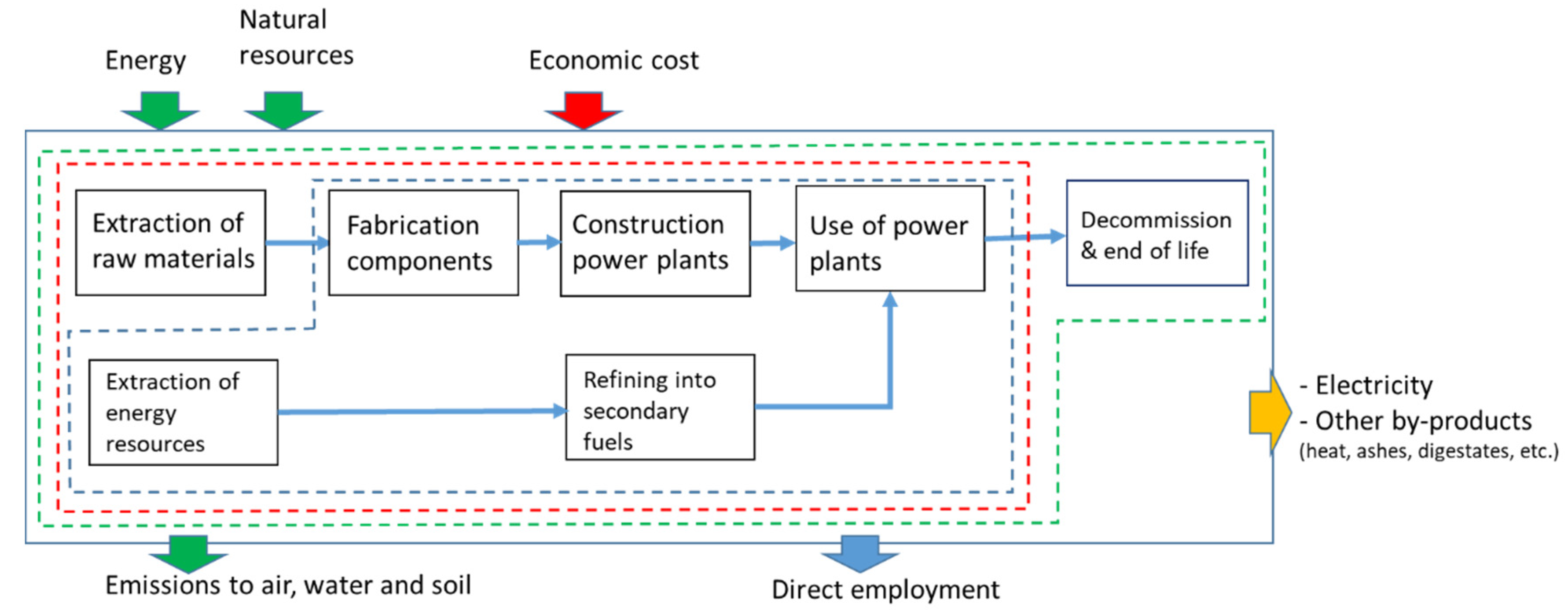

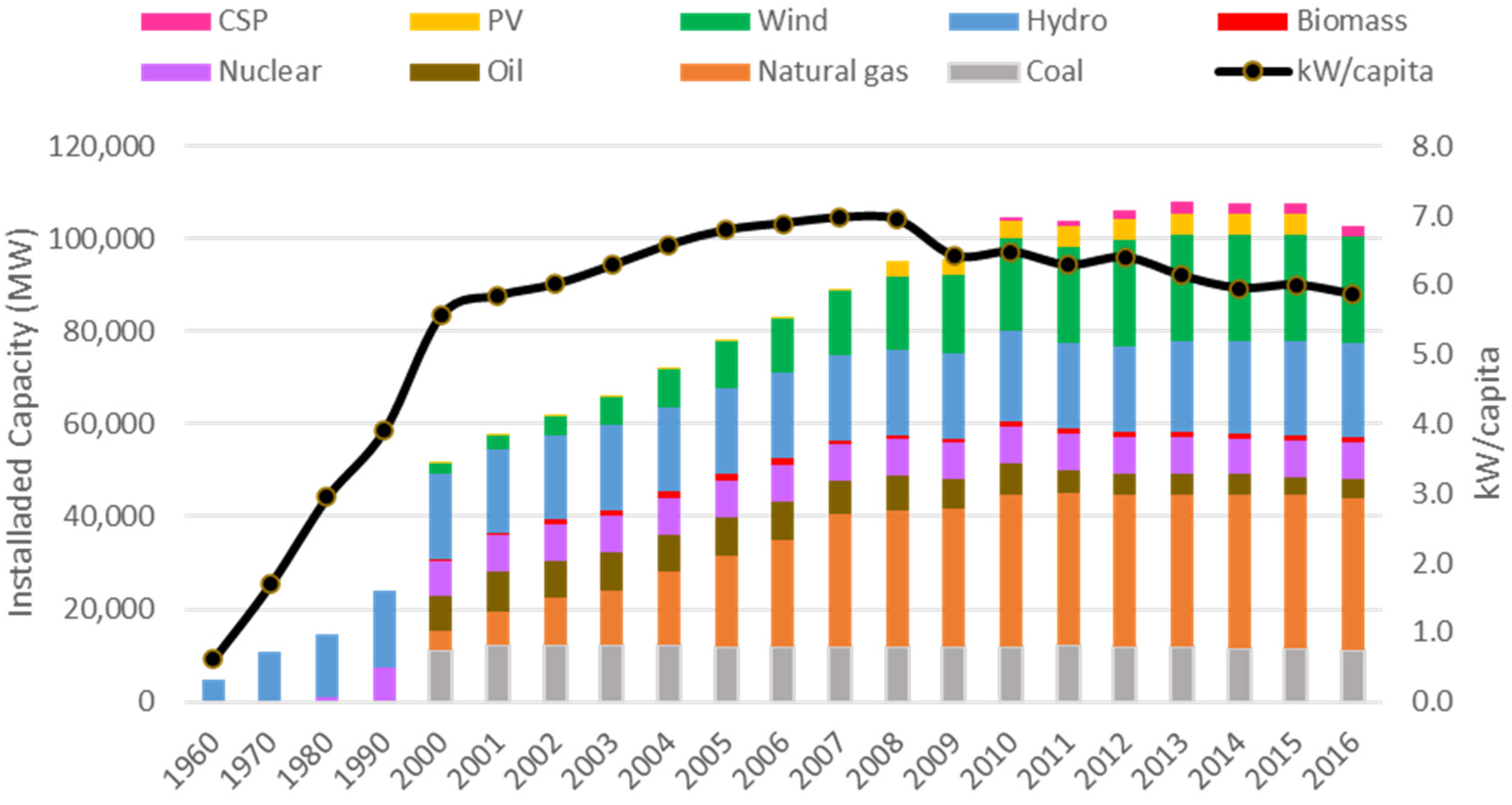
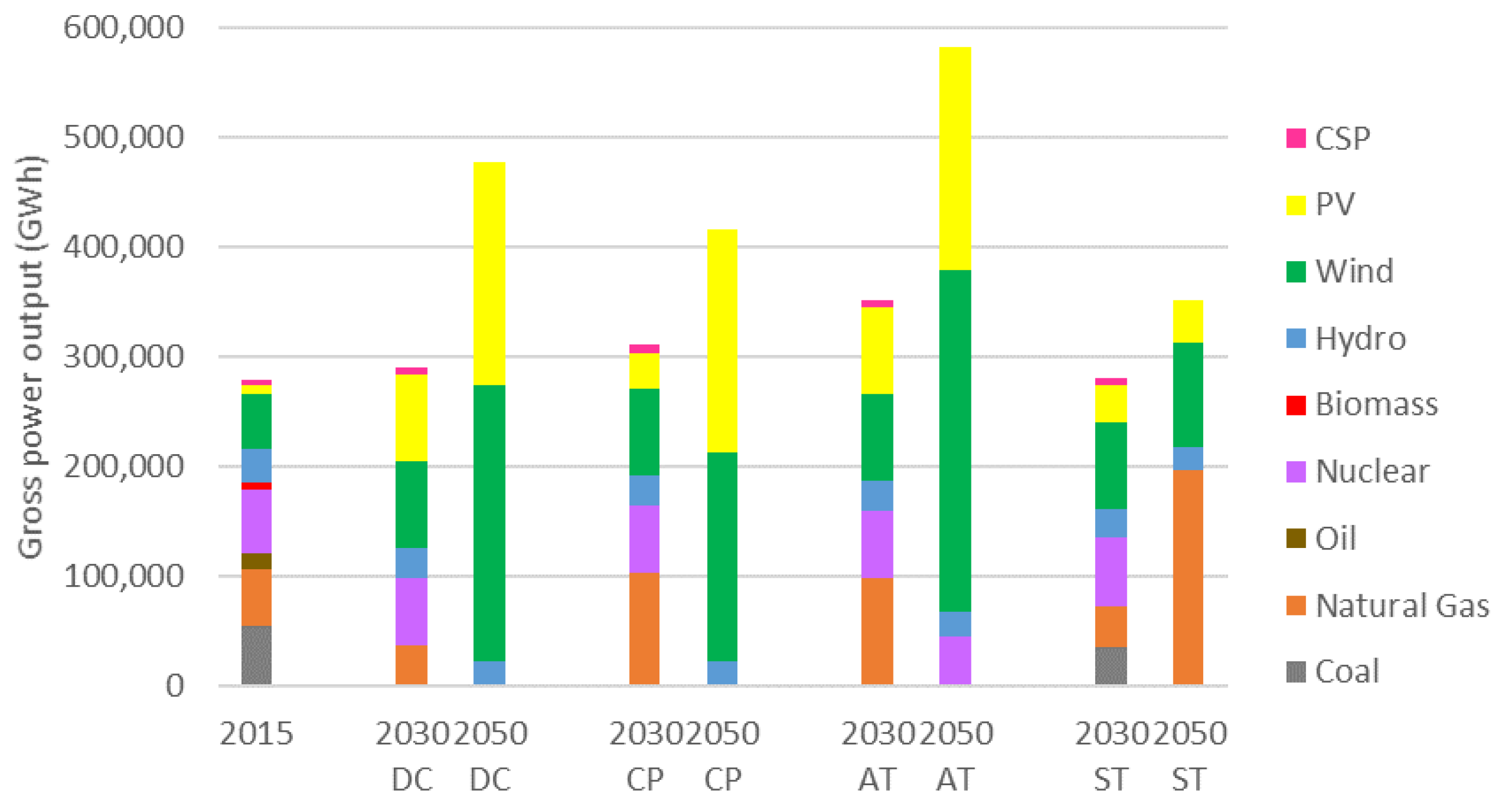

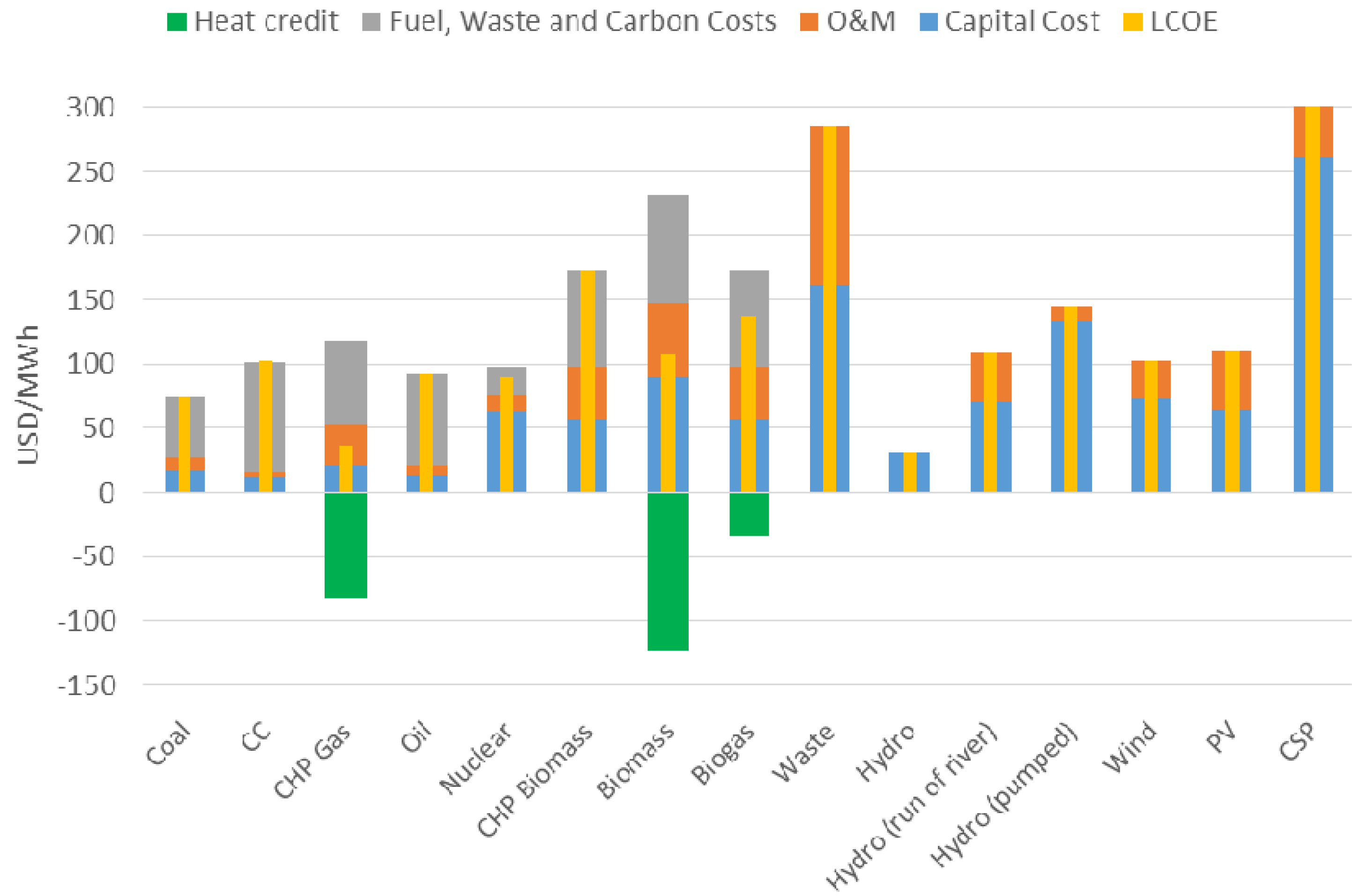
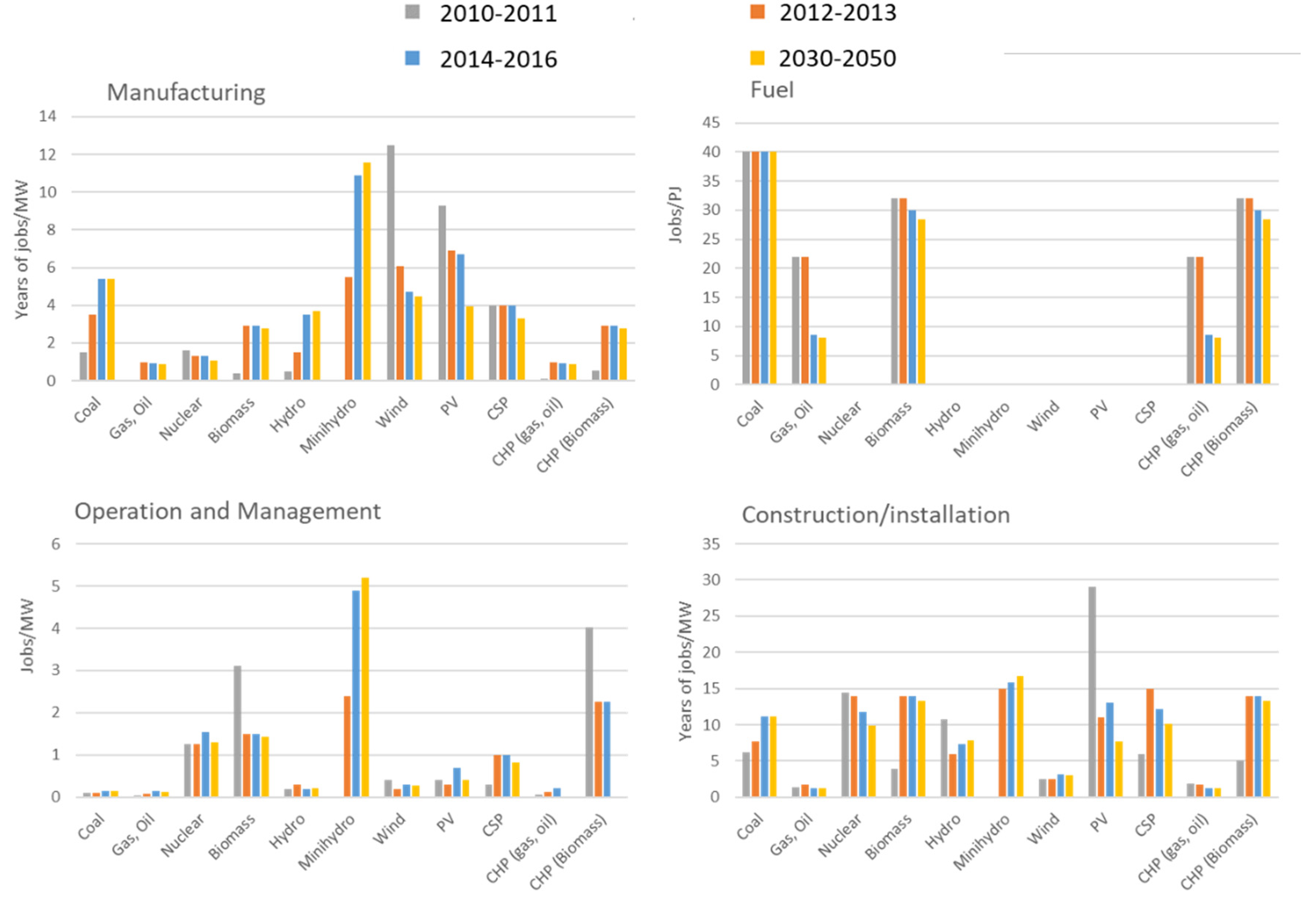
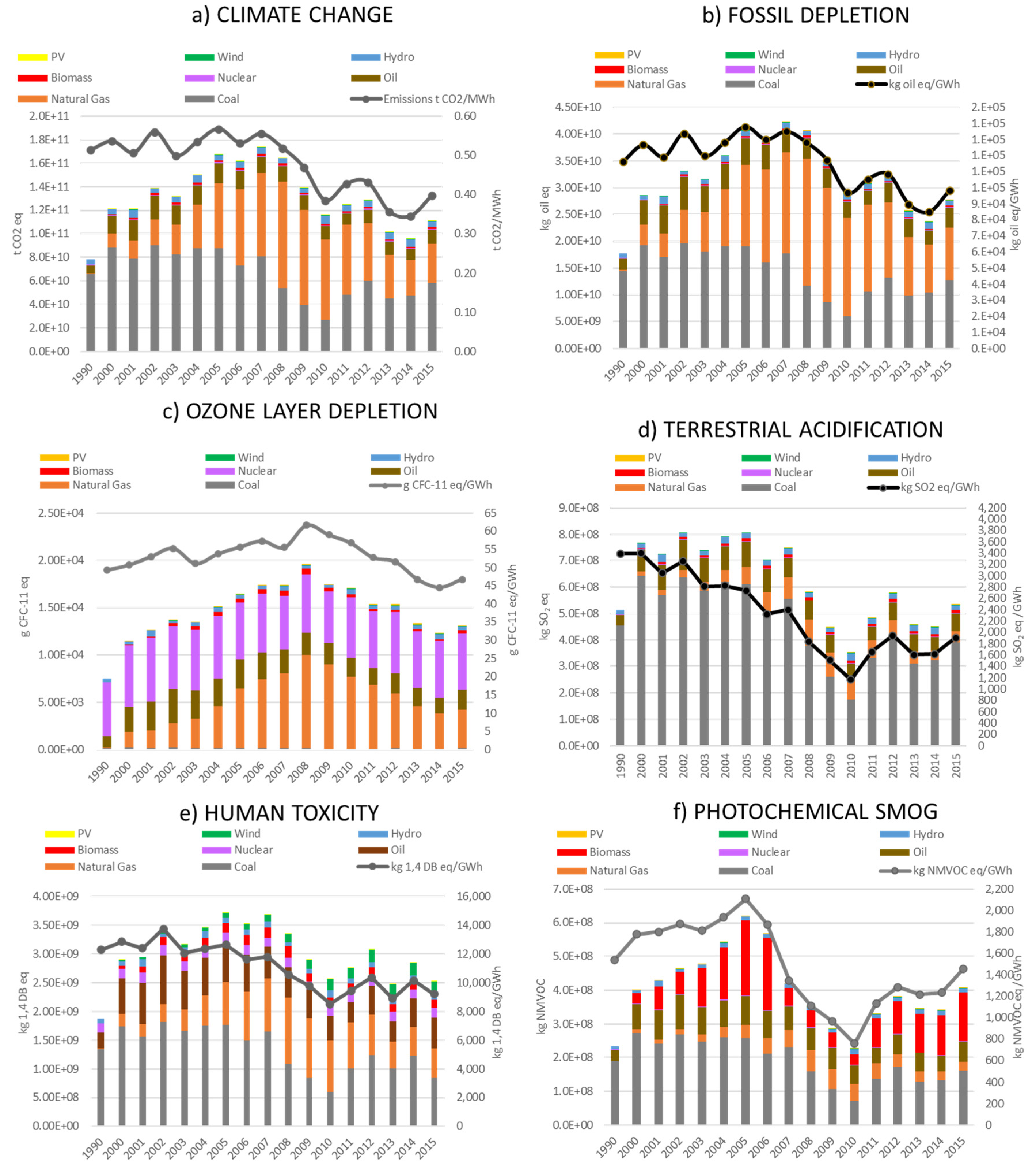

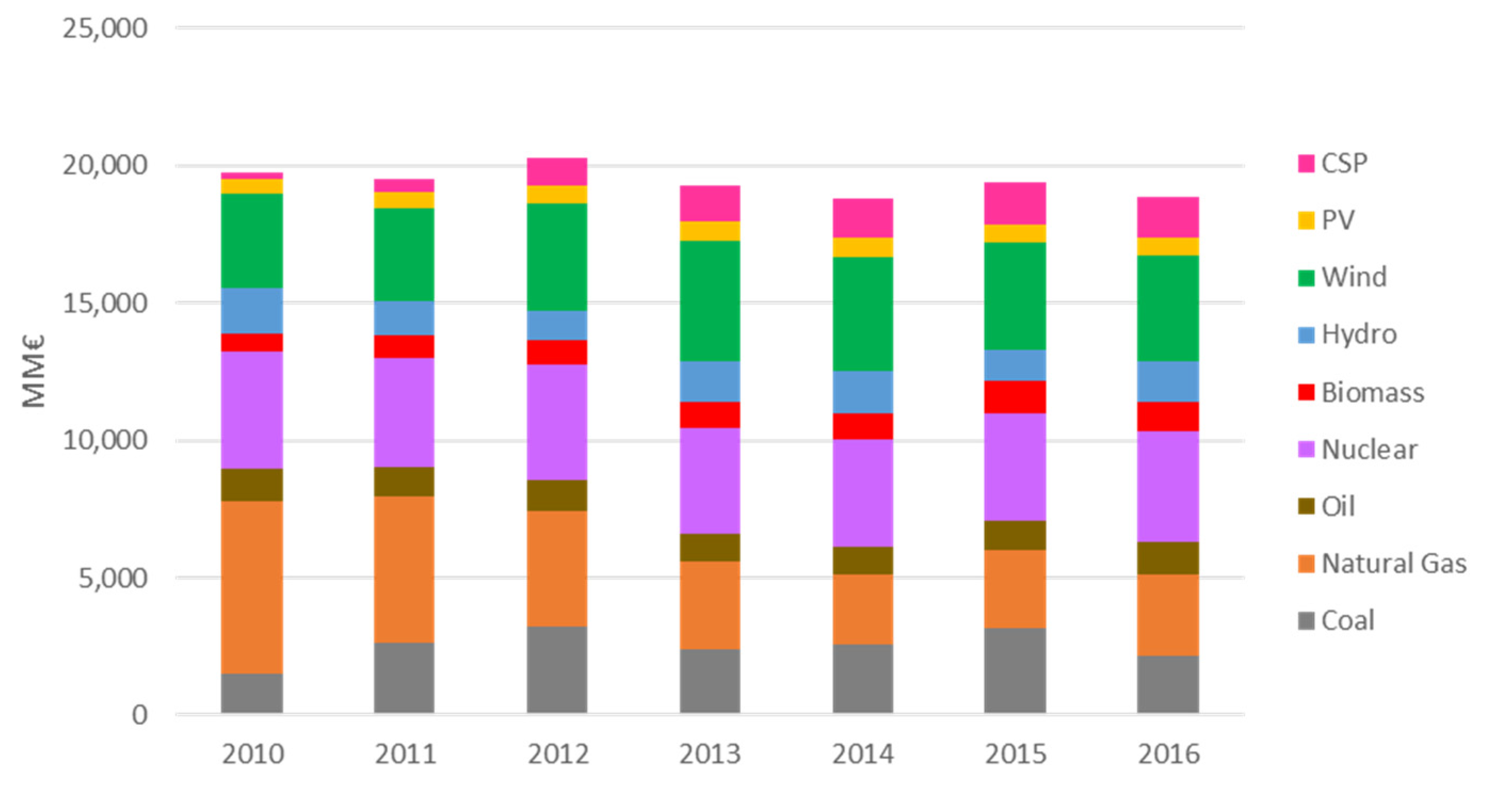
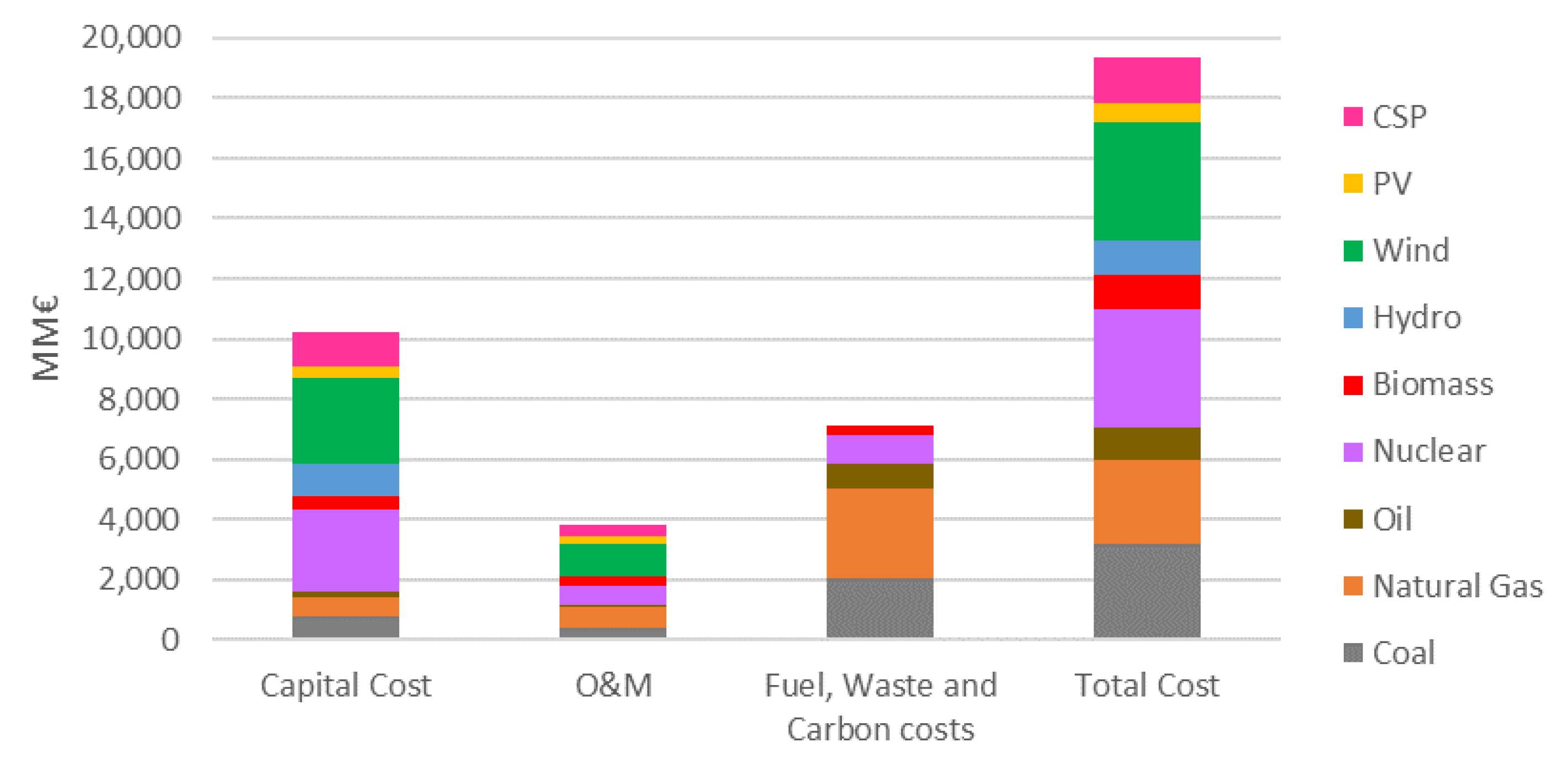

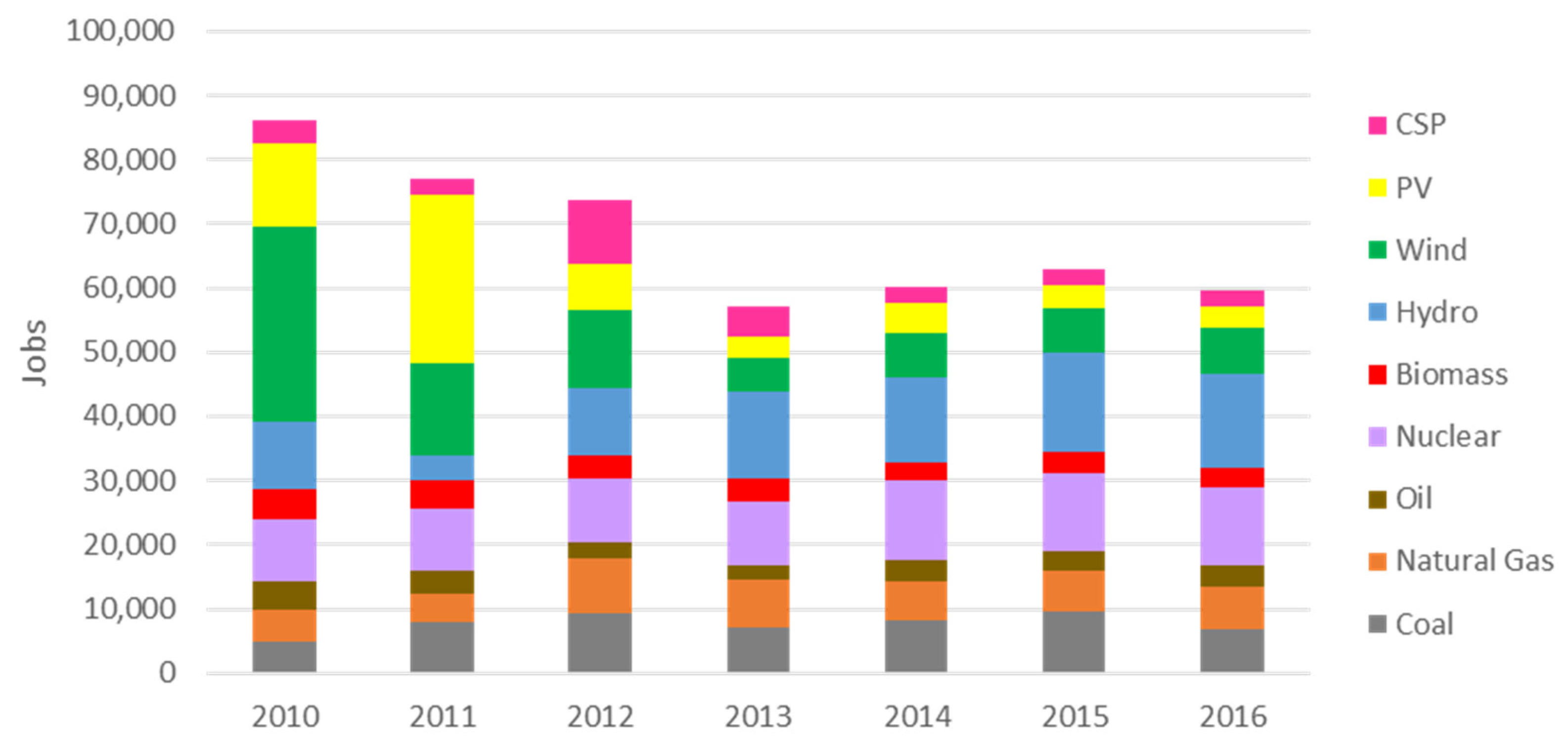
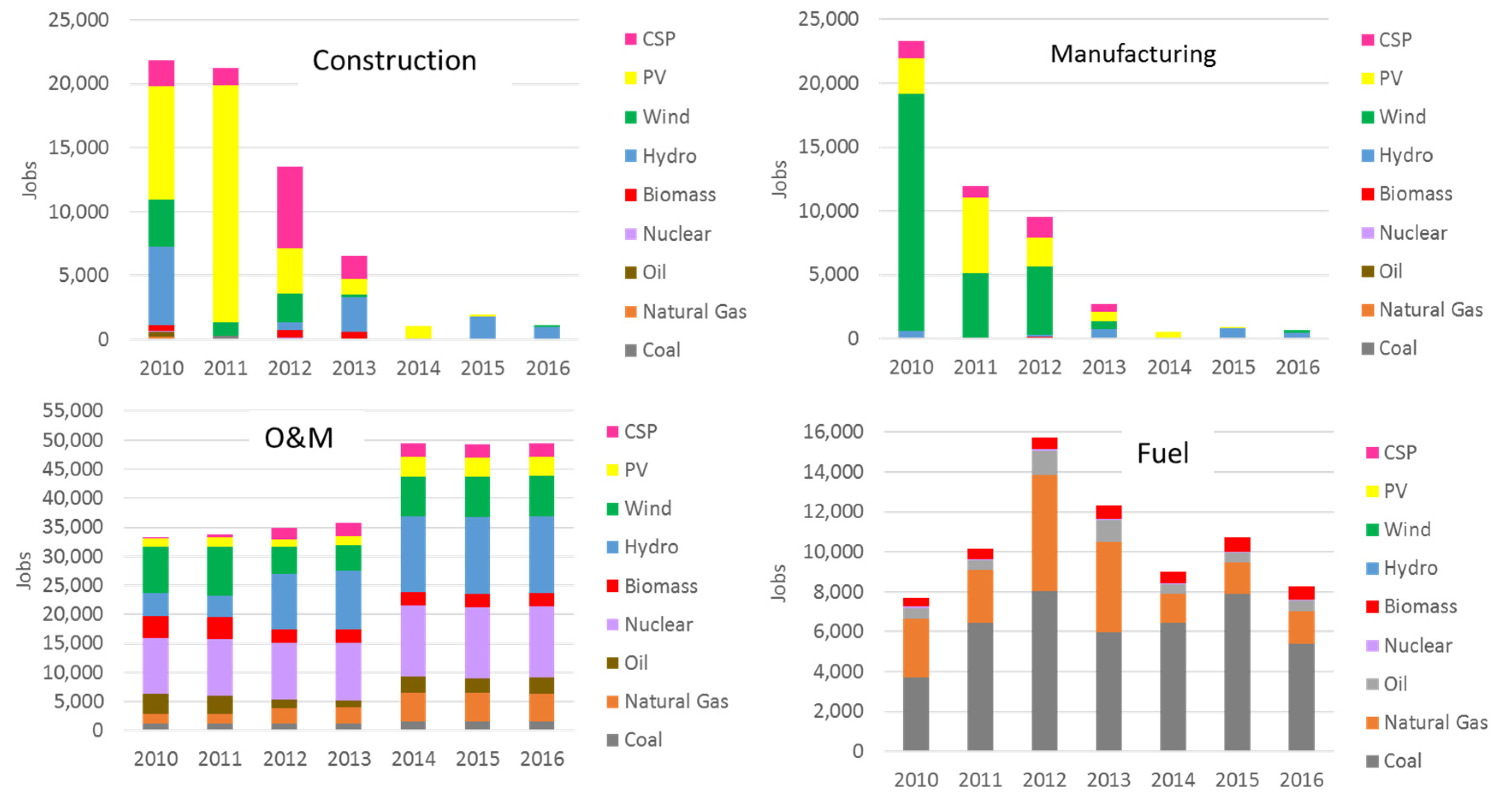
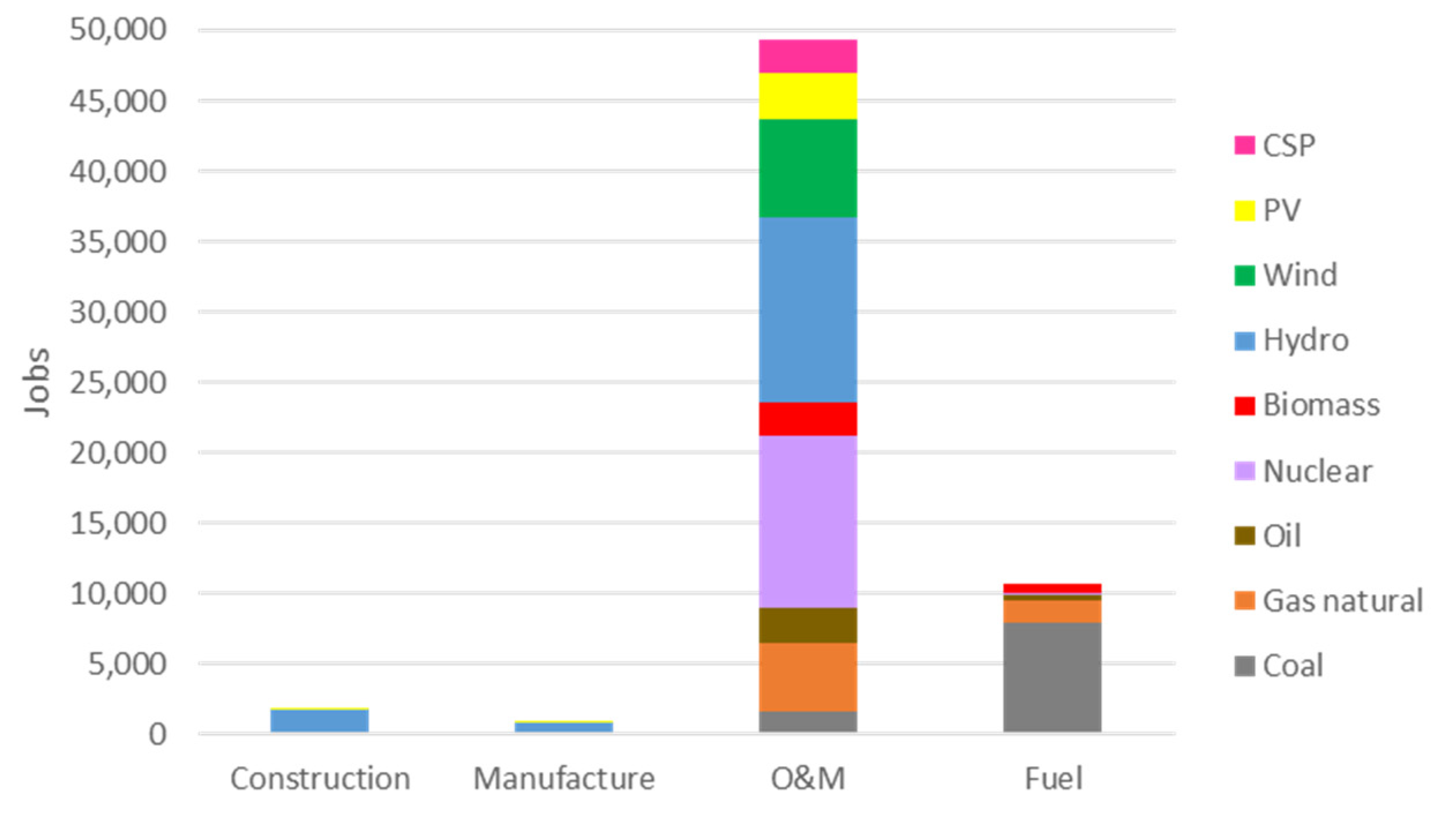

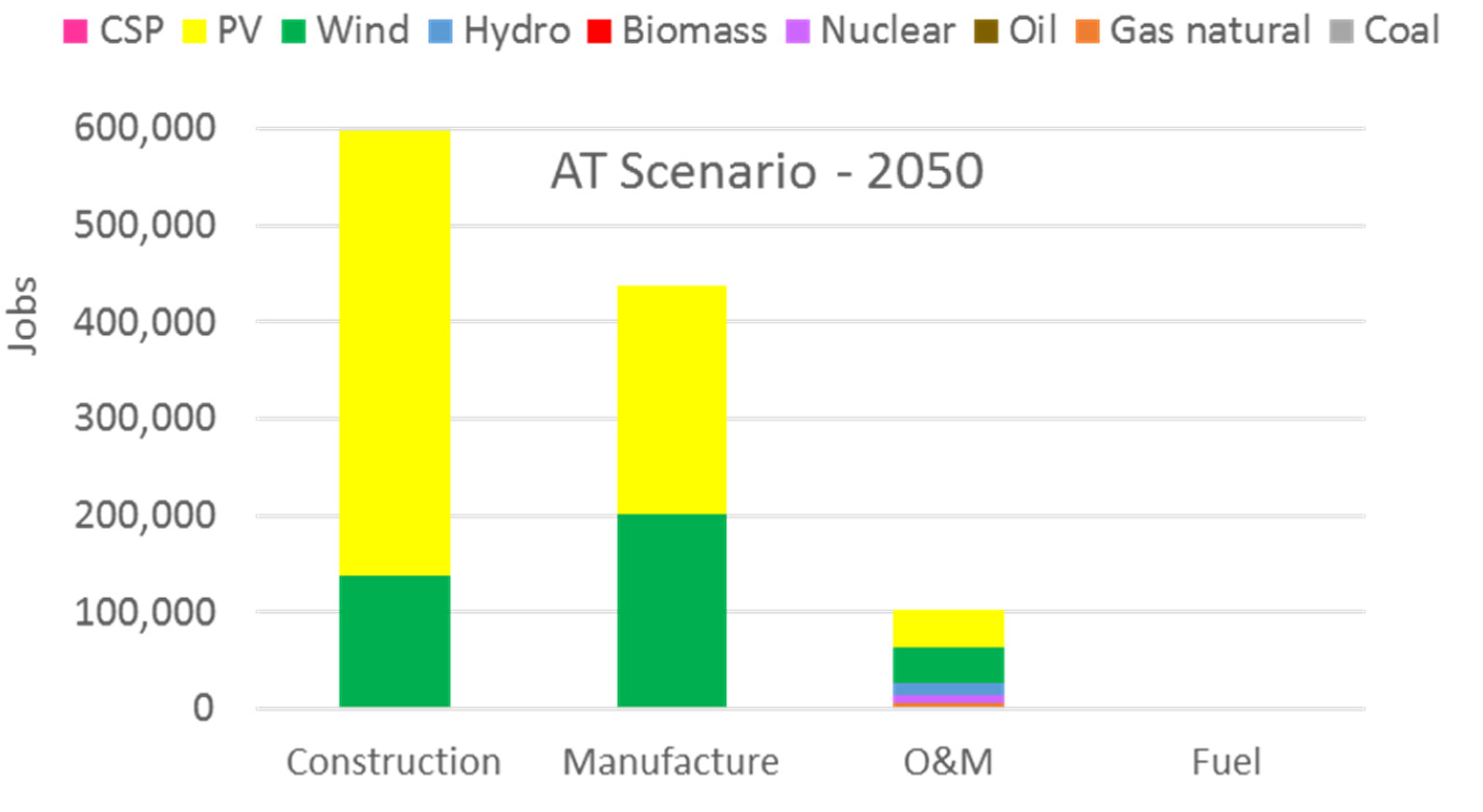
| Scenario | Year | Gross Generation (GWh) | Installed Capacity (MW) | Objectives |
|---|---|---|---|---|
| Current situation | 2015 | 279,600 | 107,769 | - |
| Decarbonization (DC) | 2030 | 290,653 | 141,968 | Ambitious reduction of GHG emissions |
| 2050 | 477,073 | 247,324 | ||
| Current Policies (CP) | 2030 | 310,997 | 112,757 | Linear evolution of international geopolitics |
| 2050 | 416,698 | 219,979 | ||
| Accelerated technology advance (AT) | 2030 | 352,260 | 153,787 | Fast penetration of RE |
| 2050 | 581,930 | 290,764 | ||
| Stagnation (ST) | 2030 | 281,460 | 108,399 | High dependency on fossil fuels. |
| 2050 | 352,507 | 108,755 |
© 2020 by the authors. Licensee MDPI, Basel, Switzerland. This article is an open access article distributed under the terms and conditions of the Creative Commons Attribution (CC BY) license (http://creativecommons.org/licenses/by/4.0/).
Share and Cite
San Miguel, G.; Cerrato, M. Life Cycle Sustainability Assessment of the Spanish Electricity: Past, Present and Future Projections. Energies 2020, 13, 1896. https://doi.org/10.3390/en13081896
San Miguel G, Cerrato M. Life Cycle Sustainability Assessment of the Spanish Electricity: Past, Present and Future Projections. Energies. 2020; 13(8):1896. https://doi.org/10.3390/en13081896
Chicago/Turabian StyleSan Miguel, Guillermo, and María Cerrato. 2020. "Life Cycle Sustainability Assessment of the Spanish Electricity: Past, Present and Future Projections" Energies 13, no. 8: 1896. https://doi.org/10.3390/en13081896
APA StyleSan Miguel, G., & Cerrato, M. (2020). Life Cycle Sustainability Assessment of the Spanish Electricity: Past, Present and Future Projections. Energies, 13(8), 1896. https://doi.org/10.3390/en13081896




